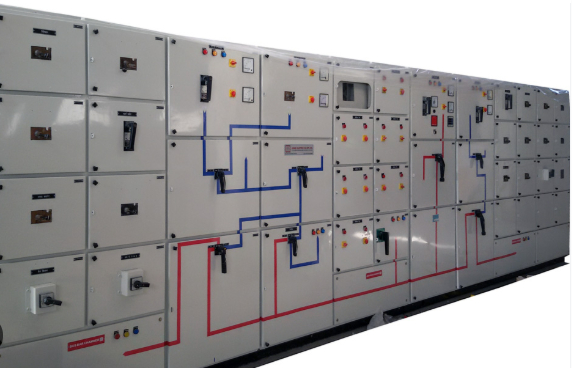AMF, MCC, PCC Panel

AMF Panel (Auto Mains Failure Panel)

ATS Panel (Automatic Transfer Switch Panel)

ATS Panel (Automatic Transfer Switch Panel)
1. Marine Classification Society Approvals
Marine control panels often need approval from one or more Classification Societies, such as:
⦁ DNV (Det Norske Veritas)
⦁ ABS (American Bureau of Shipping)
⦁ Lloyd’s Register (LR)
⦁ Bureau Veritas (BV)
⦁ RINA (Registro Italiano Navale)
⦁ NK (Nippon Kaiji Kyokai)
These organizations certify that the panel meets the marine standards for safety, construction, and performance.
2. IEC Standards (International Electrotechnical Commission)
⦁ IEC 60092 – Electrical installations in ships
⦁ IEC 60533 – Electrical and electronic installations in ships – Electromagnetic compatibility
⦁ IEC 60945 – Maritime navigation and radio communication equipment and systems – General requirements
3. Ingress Protection (IP) Rating IEC 60529
⦁ IP66 or higher – Required for protection against saltwater, dust, and humidity. (e.g., IP56 for water-resistant panels, IP66 for heavy spray).
⦁ Indicates suitability for harsh marine environments.
4. Safety & Performance Standards
⦁ SOLAS (International Convention for Safety of Life at Sea) – Mandates fire safety, emergency systems, and electrical safety.
⦁ MARPOL (Marine Pollution Prevention) – Ensures compliance with environmental regulations.
⦁ IEEE 45 (Recommended Practice for Marine Electrical Installations) – Provides guidelines for electrical systems, including control panels.
⦁ UL 508A (Industrial Control Panels) – Often referenced for component safety (though not marine-specific).
5. EMC & Electrical Safety
⦁ EN 60947 (Low-Voltage Switchgear & Control gear)
⦁ IEC 61000 (Electromagnetic Compatibility – EMC)
⦁ ATEX/IECEx (For Hazardous Areas) – Required if panels are used in explosive atmospheres (e.g., fuel tank areas).
6. NEMA Standards (for US applications)
⦁ NEMA 4X – Enclosures for indoor or outdoor use; provides protection against corrosion (suitable for marine environments).
7. ATEX / IECEx Certification (if used in hazardous areas)
⦁ Required if the control panel is used in explosive atmospheres, such as near fuel tanks or offshore platforms.
8. UL / CSA Certification (mainly North America)
⦁ UL 508A – For industrial control panels.
⦁ CSA C22.2 – Canadian equivalent.
9. EMC Compliance
⦁ Ensures electromagnetic compatibility to prevent interference with other navigation and communication systems on board.
10. RoHS / REACH Compliance (Environmental Safety)
⦁ Ensures materials used are free from hazardous substances.
Typical Documentation Provided:
⦁ Type Test Certificates
⦁ Factory Acceptance Test (FAT) Reports
⦁ Inspection and Test Plan (ITP)
⦁ Material Certificates (e.g., 3.1 per EN 10204)
⦁ Installation, Operation & Maintenance Manual
⦁ Wiring Diagrams & Component Datasheets
11. Key Considerations for Marine Control Panels
⦁ Corrosion Resistance (Stainless steel 316L or marine-grade aluminum).
⦁ Waterproof & Dustproof Enclosures (IP56 / IP66).
⦁ Vibration & Shock Resistance (IEC 60068-2-6 / 60068-2-27).
⦁ Fire Resistance (SOLAS & IMO FTP Code).
12. Regional & Flag State Requirements
⦁ EU Marine Equipment Directive (MED) – 2014/90/EU
⦁ Required for vessels operating in European waters.
⦁ US Coast Guard (46 CFR Subchapter J – Electrical Engineering)
⦁ Mandatory for US-flagged vessels.
13.Conclusion
⦁ For a marine-grade control panel to be certified, it must comply with IEC standards, classification society rules, and flag state regulations. Always verify requirements based on the vessel’s operating region and classification.